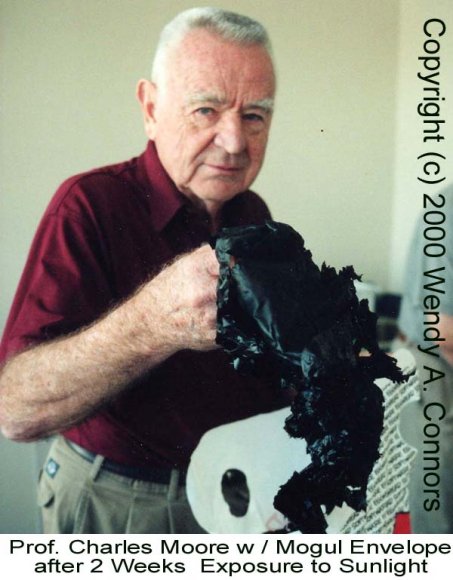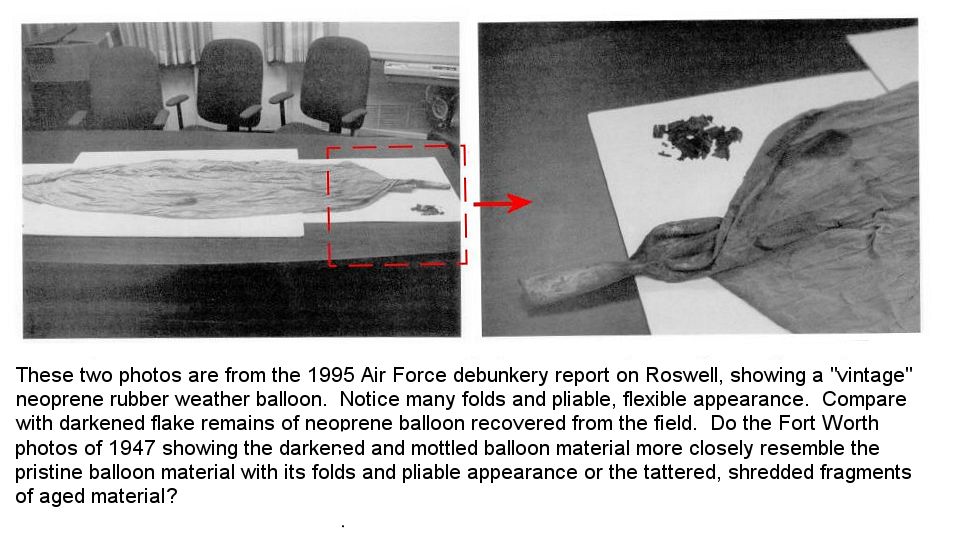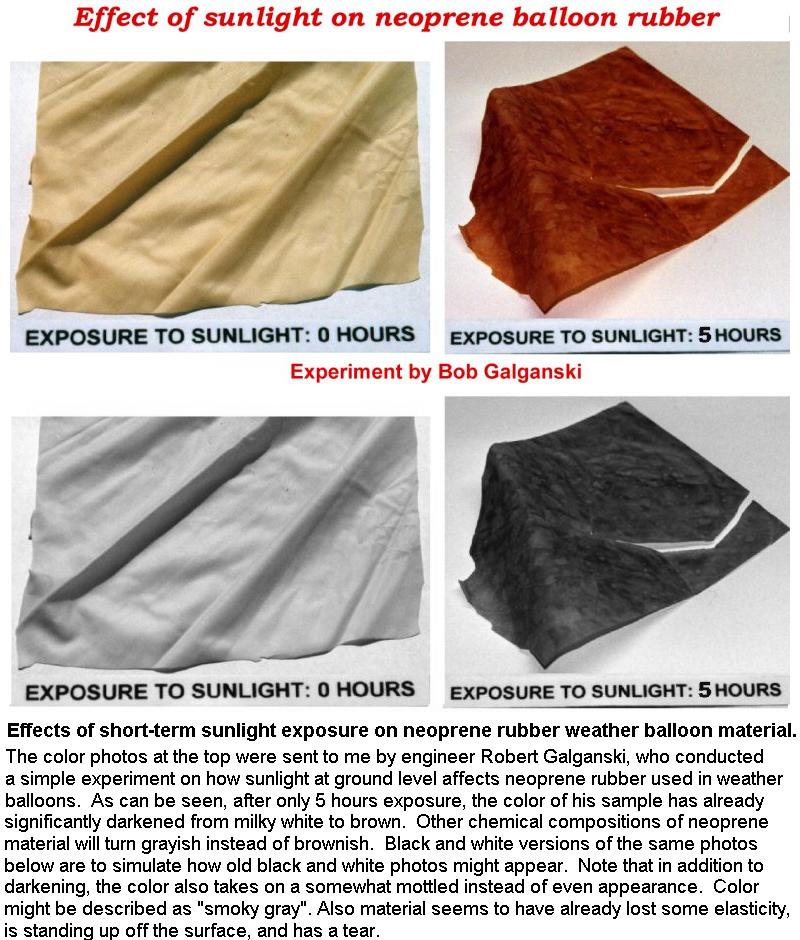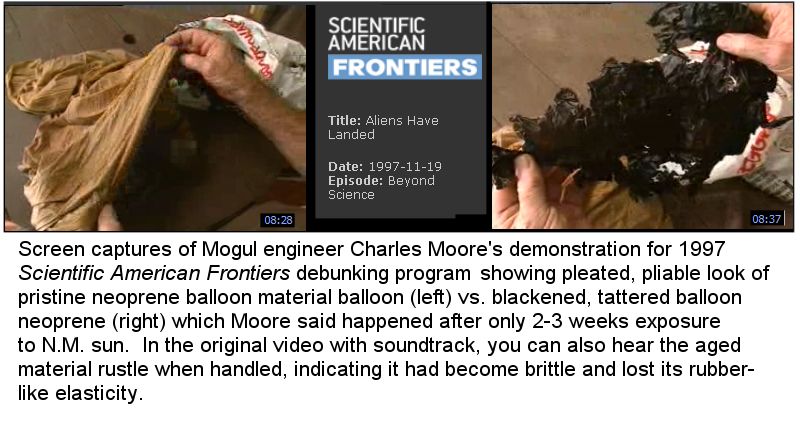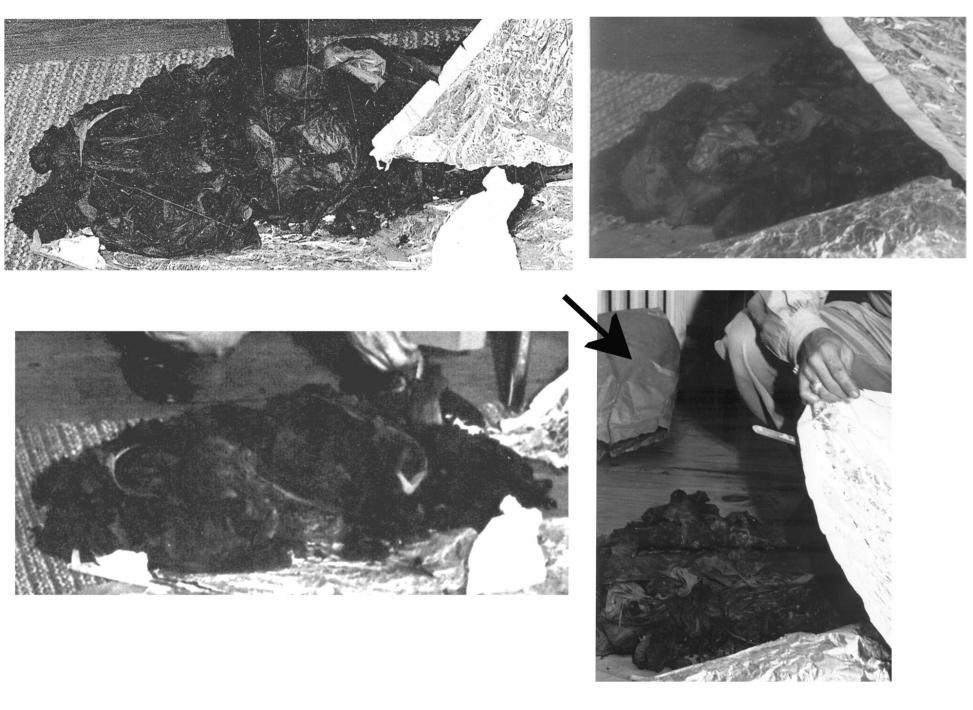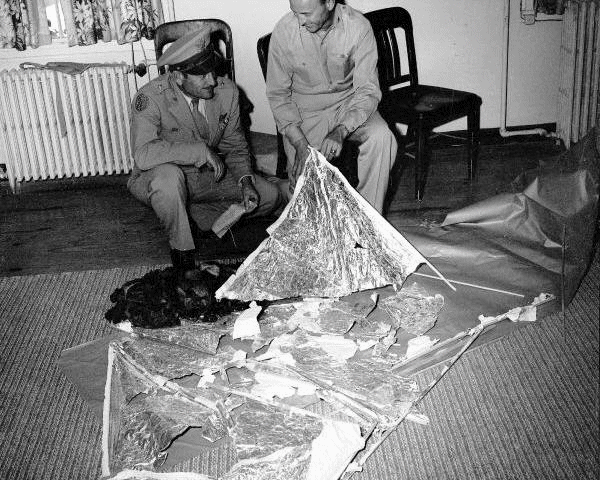Gen. Ramey's Balloon
(Effects of sunlight exposure on neoprene balloons)
Fort Worth photos of 1947 show singular weather balloon that is in much better condition would be expected for the debunkers' claimed balloon that sat in the sun for a month
The standard debunking line is that a Project Mogul balloon of June 4, 1947, (for which there isn't a scrap of documentation that it ever existed) caused the Roswell incident of July 8, 1947. The alleged crashed balloon was made up of at least two dozen weather balloons.
The rancher Mack Brazel, when interviewed late July 8 several hours after the Army had put a weather balloon explanation and had photos taken in Fort Worth, Texas, of what was supposedly found by the rancher, claimed to have collected "smoky gray" "rubber strips" scattered over a 200 yard across area, which he collected into a "bundle". He also claimed to have found the material on June 14, but left it sitting there in the sun until July 4, because he was too busy with other tasks. Therefore, according to the standard debunking scenario, the balloon material was left in the sun for a full month.
In addition, Brazel denied finding any sort of weather observation balloon, stating that he had previously found two weather balloons on his property and what he found didn't resemble either of those. But all that was shown in the public photos was a relatively intact weather balloon. How could Brazel have missed that?
This page will examine the expected condition of weathered neoprene weather balloon material after a month's exposure. Mogul engineer Charles Moore did a number of experiments, showing neoprene balloon material after only 2 to 3 weeks exposure to New Mexico sun (Moore lived in Socorro). In the 1995 debunking Roswell report by the Air Force, Moore was also interviewed and showed them an example. It was compared to blackened "paper ash. "
Moore added in his Air Force affidavit, "Some of the material would almost look like dark gray or black flakes or ashes after exposure to the sun for only a few days."
Notice here Moore talking about the flown balloon material breaking up into little pieces after only a few days. Exposure of the neoprene at high altitudes to highly intense UV radiation for even a few hours would be the equivalent of at least a day or two of strictly ground exposure.
Here are some screen captures from a 1997 Scientific American Frontiers debunkery program with Moore showing a pristine balloon, then his experimental neoprene balloon material exposed for only 2 to 3 weeks down on the ground.
Here are two photos from the 1995 USAF Roswell debunkery report, again supposedly supporting what Moore was saying. It shows a pristine, pleated weather balloon stretched out on a table with blackened fragments of neoprene balloon material recovered from the field after an indefinite period of time. The point they were again making was that the neoprene darkened and thus supposedly "matched" Brazel's "smoky gray" description. But it is disintegrated and in flakes and not Brazel's claimed "rubber strips". We will soon compare to Fort Worth photos (which show neither a bunch of flakes nor rubber strips, but a relatively intact balloon)
Here is another demonstration by Moore from 2000, again showing very blackened and tattered balloon material, this time after just 2 weeks sun exposure.
(Photo courtesy of researcher Wendy Connors of Albuquerque:)
Here is a demonstration by engineer Robert Galganski, who is very skeptical of the Mogul explanation. Galganski lives in Buffalo, New York, so hardly the more intense sunlight in the high desert of New Mexico. But still notice just how quickly the neoprene darkens and stiffens up after only 5 hours exposure to sunlight on the ground. (Again, a real flown weather balloon in the upper atmosphere with its much more intense UV light would have darkened up and stiffened even more after a few hours of flight.) I have also converted Galganski's color photos to black and white, to more directly compare appearance to Fort Worth photos.
So what this all proves is that the neoprene balloon material that had actually flown would still end up darkened after a very brief amount of time. Galganski's sample after only 5 hours in black and white already has a "smoky gray" and mottled appearance (in B&W version). Further, if a neoprene balloon didn't lie in the sun for weeks at a time, as is the claim for what the rancher found, then it would be darkened but still retain some of its original pleated, rubber-like appearance. But if it had been flown at high altitude and then lay on the grouind in the sun for only a few days, according to Moore himself in his affidavit, it would already be disintegrating into black "flakes or ash"
Now, finally, lets compare to what was shown in the Fort Worth photos. First, multiple views from multiple pictures (note: right click and open in new page to see at full size)::
The things I note here are:
- Mottled appearance, with many lighter patches (compare to Galganski 5 hour B&W photo above), not the uniformly black appearance of Moore's demos where material had been exposed to sunlight for 2 to 3 weeks.
- Pleated, pliable appearance of a relatively fresh balloon, though one that has obviously had some sun exposure to cause darkening. This would probably be the appearance of a balloon that had flown at high altitudes with intense UV exposure, but lain on the ground for only a very brief period, not the one month that Roswell debunkers claim.
- A balloon that had flown then lain on the ground exposed to the sun for a month should instead of the very tattered appearance of Charles Moore's demos, including all sorts of small black flakes lying all over the ground, which Moore said could happen after only a few days. There are probably a few small dark specks, possibly from the balloon material, but nothing like what would really be seen after a month's sun exposure, also being blown by wind, then supposedly gathered into a bundle. And where are all those "rubber strips" scattered over 200 yards? This looks very much like a mostly intact, solitary weather balloon, which is exactly how it was referred to by General Ramey and his people at the time, including his weather officer.
The arrow in the graphic points to a round paper package leaning up against Ramey's radiator. In high-resolution it appears to be open at the bottom and just the right size for stuffing the weather balloon into (speculation). Again, after all this handling and element exposure, why wouldn't a month-old balloon just be nothing but small black flakes when dumped out on the floor?
Another important point is that a real Mogul balloon would have been made up of around two dozen similar weather balloons. Where are they? All we have is Ramey's self-described singular balloon.
To further give you an idea of just how little balloon material is in the photos, I have recreated the scene with a computer ray-tracer (POV-ray). This is the famous photo of Gen. Ramey holding the Ramey memo in his hand, with his chief of staff, then colonel Dubose sitting next to him. Dubose as a retired brig. general would later go on record that the balloon wreckage in the photos was nothing but a cover story to divert the attention of the press. (see Dubose page)
The main point here is that the approximate dimensions of the balloon heaped on the ground can be determined and the approxi-mate volume computed. The balloon shape is approximated by a half-ellipsoid, with dimensions of ~2.2' long x ~1.1' wide x ~.35' high. The volume of the ellipsoid would be about 0.44 cubic feet, or the volume of a "shoe box" only 12" x 10" x 6" (30 x 25 x 15 cm).
So besides the balloon material properties in the photos not really matching up with what rancher Brazel described, and with even less in common with what would be expected for material laying in the sun for a month, there is hardly anything there, just a slightly used, singular weather balloon that would fit in a show box..
In fact notice how little is really there overall. The foil/balsa wood torn-up radar target in the photo also adds up to only one target. Yet debunker Karl Pflock fatuously declared in his 2001 book ("Roswell: Inconvenient Facts and the Will to Believe"):
"The photographs of the debris unquestionably show the remains of more than one ...radar target and several degraded ...neoprene balloons.
Oh really? And how exactly did Pflock determine those "inconvenient facts" that nobody dare question? It turns out the "unquestionable" comes from Charles Moore again, who told Pflock this based on nothing more than his simple eyeball assessment of the photos, with no attempt to actually measure and quantify the amount of material, as I did scientifically through computer reconstruction of the scene.
So in the end, all we have is a shoe-box of balloon material, about exactly what one would expect for a SINGLE, standard, 350 gram (12 ounce) weather balloon (and about the size of the round paper package in the photos), and a single radar target which also weighed 350 grams or less. This doesn't add up even a third of rancher Brazel's "five pounds" of debris he said he collected into two small bundles.
It turns out that in this one instance Gen. Ramey was telling the truth. He always referred to the weather balloon and radar target in the singular back in 1947. (See, e.g., FBI telex of July 8, 1947, which uses the singular description.) All that was in his office was an ordinary radar target weather balloon used by weather services, an assessment also given by his weather officer Irving Newton back then as well as in the present when interviewed, including by me. Newton said then and now it could have come from anywhere. Newton also told me and others that although highly skeptical of the Roswell flying saucer, he doesn't believe what he viewed had anything to do with Mogul.
A real Mogul balloon train made of rubber weather balloons typically consisted of at least two dozen 350 gram balloons, and several radar targets, if they carried any at all. Total weight was typically in the 60 pound range. Not only is there no real Mogul that can be matched up, the material is but a very tiny fraction of what would be expected from a real Mogul crash site.
As Gen. Dubose said, the weather balloon in the photos was nothing but a cover story to divert the attention of the press from what had really happened and really been found. You would think he would know. He was Ramey's chief of staff and was actually there, pictured sitting to the right of Ramey above.
If you listen carefully to the original video (right), you can even hear the blackened neoprene rustle like cellophane, indicating that it has lost it's elasticity. Also note that it is in tatters, breaking up, and falling apart, quite unlike the pleated, pliable original neoprene balloon material. ( Program segment., Episode 2, "Beyond Science?", starting at 26.55)
